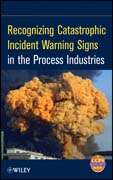
Recognizing catastrophic incident warning signs in the process industries
This book provides guidance on characterizing, recognizing, and responding towarning signs to help avoid process incidents and injuries before they occur.The guidance can be used by both process safety management (PSM) professionals in evaluating their processes and PSM systems as well as for operators who are often the frontline defense against process incidents. Warning signs may consist of process deviations or upsets, instrumentation warnings or alarms, past operating history and incidents, observable problems such as corrosion or unusual odors, audit results indicating procedures are not being followed, or a number of other indicators. Filled with photos and practical tips, this book will turn anyone in a process plant into a hazard lookout and will help preventpotential incidents before they turn into catastrophic events. INDICE: List of Tables xix List of Figures xxi Files on the Web Accompanying This Book xxii Acknowledgements xxv Foreword xxvii Preface xxix 1. Introduction 1 1.1 Process safety management 3 1.2 Normalization of deviance 4 1.3 A strategy for response 5 1.4 Maintaining organizational memory and a healthy sense of vulnerability 7 1.5 Risk based process safety 8 1.6 Our target audience 11 1.7 How to use this book 12 1.8 Case study Toxic gas release in India 13 2.Incident Mechanics 17 2.1 Incidents do not just happen 17 2.2 Incident models17 2.3 Case study Benzene plant explosion in China 27 3. Leadership and Culture 29 3.1 How does leadership affect culture? 29 3.2 The leadership and culture related warning signs 32 3.3 Case study Challenger space shuttle explosion in the US 46 4. Training and Competency 49 4.1 What is effective training and how is competency measured? 49 4.2 The training and competency related warning signs 51 4.3 Case study Gas plant vapor cloud explosion in Australia 62 5. Process Safety information 65 5.1 Critical information to identify hazards and manage risk 65 5.2 The process safety information related warning signs 66 5.3 Case study Batch still fire and explosion in the UK 6. Procedures 79 6.1 Safe and consistent operation 79 6.2 The procedure related warning signs 81 6.3 Casestudy Nuclear plant meltdown and explosion in the Ukraine 95 7. Asset Integrity 97 7.1 Systematic implementation 97 7.2 The asset integrity related warningsigns 99 7.3 Case study Refinery naphtha fire in the US 114 8. Analyzing Riskand Managing Change 177 8.1 Risk management 117 8.2 The risk analysis and management of change related warning signs 121 8.3 Case study Cyclohexane explosion in the UK 9. Audits 139 9.1 Audits support operational excellence 139 9.2 The audit related warning signs 141 9.3 Case study Chemical warehouse fire in the UK 10. Learning From Experience 149 10.1 Methods for continuous improvement149 10.2 The learning from experience warning signs 151 10.3 Case study Spaceshuttle Columbia incident in the US 159 11. Physical Warning Signs 163 11.1 The everyday things matter 163 11.2 The physical warning signs 164 11.3 Case study Resin plant dust explosion in the US 172 12. A Call to Action 175 12.1 Actions you can take now for each warning sign 176 12.2 A simple plan to considerfor rigorous implementation and follow-up 177 12.3 Actions to consider 180 12.4 Summary 183 Appendix A. Incident Warning Sign Self Assessment Tool 187 Appendix B. Composite List of Catastrophic Incident Warning Signs 199 References &Selected Regulations 205 Acronyms and Abbreviations 213 Glossary 215 Index 221
- ISBN: 978-0-470-76774-0
- Editorial: John Wiley & Sons
- Encuadernacion: Cartoné
- Páginas: 272
- Fecha Publicación: 15/11/2011
- Nº Volúmenes: 1
- Idioma: Inglés
